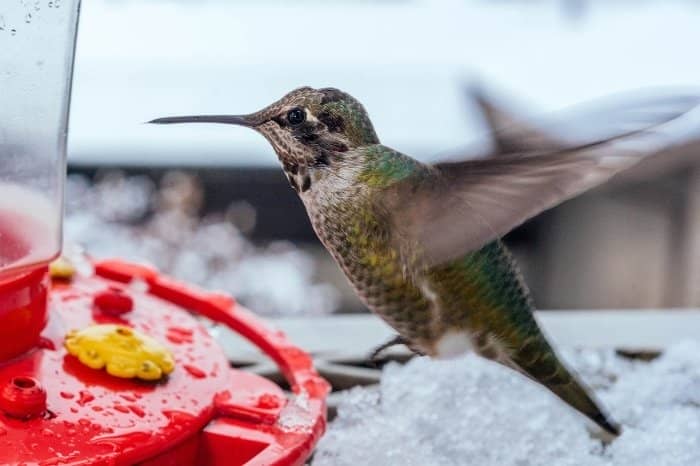Did you know that the hummingbird body temperature is higher than most other birds? This helps them to stay active and energetic even when the weather is hot.
We’ll explore how hummingbirds keep their body temperature high, and what they do to cool down when it’s too hot. We’ll also take a look at some of the challenges hummingbirds face in extreme weather conditions.
How Hummingbirds Control Their Body Temperature
So what temperature can hummingbirds survive? Hummingbirds are well known for their amazing ability to fly and navigate, but what is not as well known is their incredible ability to control their body temperature. Unlike most animals, which must rely on external conditions to keep themselves warm or cool, the hummingbird body temperature is regulated internally.
At night, when temperatures drop, the hummingbird body temperature also drops and the bird enters a state of torpor. This means that they lower their metabolic rate and body temperature drastically in order to save energy. In this state, the birds can be considered technically “cold-blooded”, since their body temperature no longer matches that of their environment.
However, unlike true cold-blooded animals like reptiles, hummingbirds manage to do this without losing the ability to move and function normally. So do hummingbirds get hot?
Experts believe that it has to do with the birds’ rich capillary tissue and unusually rapid metabolism. By rapidly flapping their wings and beating their gossamer-thin feathers together, hummingbirds create tiny areas of turbulent air around them. This insulates them from changes in the environment and helps maintain a consistent body temperature even when the weather gets very cold or very hot.
Check Out Hummingbird Season In Alabama? 3 Tips To Get More Visitors This Year
Why Hummingbirds Have Such a High Temperature
The high level of the hummingbird body temperature helps them to stay active during cold weather and to digest their food quickly. Their metabolism is very fast, which means they burn a lot of energy and generate a lot of heat.
They also have a high basal metabolic rate, meaning that they need to consume a lot of food in order to maintain their body temperature. This high metabolism is necessary because hummingbirds have such a small body size; if their metabolism was any slower, they would not be able to survive.
Hummingbird Egg Temperature
Hummingbird eggs must be kept at a very specific temperature in order to hatch successfully. The average hummingbird body temperature is 106°F, and the eggs must be kept at a similar temperature. If the eggs get too cold, they will not develop properly. However, if they get too hot, the embryos will begin to overheat and die. As a result, hummingbirds must carefully regulate the temperature of their nests.
Hummingbirds will often build their nests in locations that offer some protection from the sun, and they will also use materials that help to insulate the eggs. By taking these measures, hummingbirds can ensure that their eggs are kept at the perfect temperature for hatching.
AQUEENLY Hummingbird House Set of 3 Hand Woven Hummingbird Houses Nest Small Hanging
Hummingbird Body Temperature During Torpor
Hummingbirds are known for their incredible energy and agility, flitting around at high speeds and effortlessly hovering in mid-air. However, even such active creatures need a way to conserve their energy when conditions become too harsh. That’s where the phenomenon of torpor comes in.
During normal daytime hours, the hummingbird body temperature moves around 100°F. But during periods of shallow torpor, they can drop that temperature by as much as 20 degrees without experiencing any negative effects.
If conditions are especially chilly or food is scarce, hummingbirds can enter into a deep state of torpor, during which their bodies hover around 50 degrees below their normal clockwork temperatures. This supercooled state allows them to survive during lean times and weather extremes, making them truly remarkable creatures indeed.
How do Hummingbirds Survive the Cold Temperatures
There are a few different mechanisms that hummingbirds use to survive the cold temperatures. One is to increase their internal body temperature. They do this by shivering and contracting their muscles, which generates heat. There’s also another strategy to keep the hummingbird body temperature at a good level, and that’s by decreasing their activity level.
When they’re not active, they don’t generate as much heat, and they can save energy by not having to produce as much body heat. Hummingbirds rarely huddle with other hummingbirds to keep warm. If they weren’t as solitary, this could help them share warmth and conserve energy.
But what’s the coldest temperature a hummingbird can survive? The coldest temperature a hummingbird can tolerate is about -5°F. But they won’t survive long at that temperature. If the temperature dips much below freezing, they will go into hypothermia and die.

What About the Nectar Temperature
The hummingbird body temperature is high, so should their nectar also be warm? The ideal temperature for hummingbird nectar is between 80 and 85°F. Hummingbirds prefer to drink nectar that is fresh, so it’s important to change the nectar solution often. But how cold is too cold for hummingbird nectar?
If the solution becomes too cold, the hummingbirds may not be able to drink it. If it gets too hot, the nectar will spoil and the hummingbirds may get sick. You can buy a special feeder that has a built-in heater to keep the nectar at just the right temperature.
Bottom Line: Hummingbirds Have the Highest Temperature Among Bird
Did you know that the hummingbird body temperature is the highest of any bird? In fact, their internal thermometer can reach up to 107°F! This is one of the many fascinating facts about these tiny birds. We hope you enjoyed learning about them as much as we enjoyed writing this post.
Are there any other interesting hummingbird facts that we missed? Let us know in the comments below!
FAQ’s
[rank_math_rich_snippet id=”s-98919717-8260-4015-926a-e64f6b22358c”]


